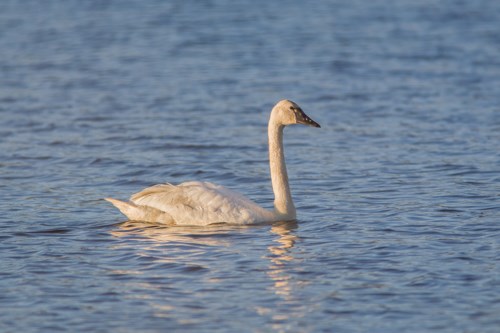
NPS/Gordon Dietzman IntroductionTundra swans, while our smallest swan, are still very large birds. With a wingspan of five and a half feet an individual may weight 14.5 pounds. The tundra swan can be distinguished from its larger relative, the trumpeter swan, by a small splash of yellow at the base of the bill. The tundra holds its neck straight up while swimming on the water, while the non-native mute swan neck is usually held in an arc. The tundra swan's call is a clear goose-like honk that may sound like a musical hoot at a distance. At rest, a flock of tundras often communicate using a mellow murmuring. It was once thought that North American migratory birds followed roughly one of four migration corridors between nesting and wintering areas. Banding studies, however, have shown that this isn't true for all species. Tundra swans, for example, may nest as far west as the cold Arctic tundra in Alaska, but cut southeast across the Pacific, Central, Mississippi, and Eastern flyways to winter along the Chesapeake Bay on the eastern coast of the United States. Where to FindAs these beautiful birds move southeast, their path intersects the Mississippi River over the Mississippi National River and Recreation Area. They are often seen flying high overhead and their mellow calls may be heard at night as they migrate along the Mississippi River. South of the Twin Cities, however, they find find good feeding and loafing areas at Rieck's Lake just north of Alma, Wisconsin and on the Mississippi River south of Brownsville, Minnesota. Riek's Lake is the better of the two places to see these birds up close, although rapid siltation of the lake and the emergence of bur reed has seriously diminished the flocks of swans. A restoration project was conducted in 2005, but it may be a few years before flocks once again use the area in historical numbers. There is an observation area at this location, often staffed by volunteers that are happy to share information with visitors. The Mississippi River south of Brownsville, however, will hold thousands of these birds, although they are at some distance from the viewing areas. Both places are worth a visit in early November, until the water freezes up forcing the birds to leave and head east towards their east coast wintering areas. The swans use other areas along the Mississippi River as well, but these two places offer the best chances to view and photograph these beautiful birds. Fascinating Facts
Identification
|
Last updated: December 28, 2017
